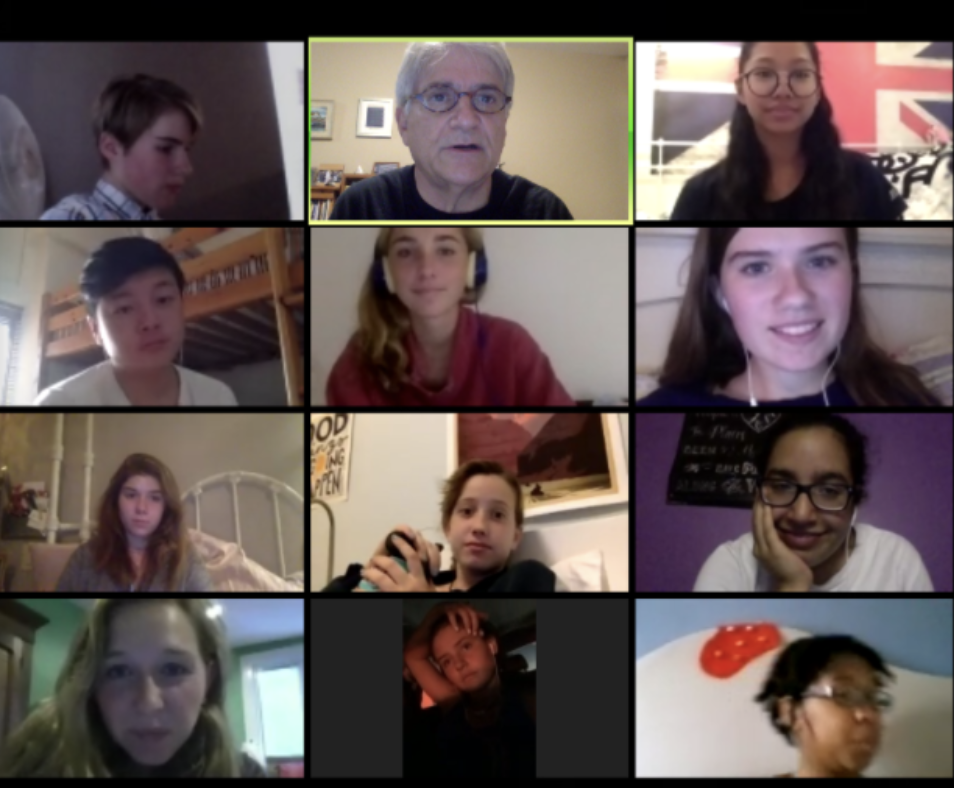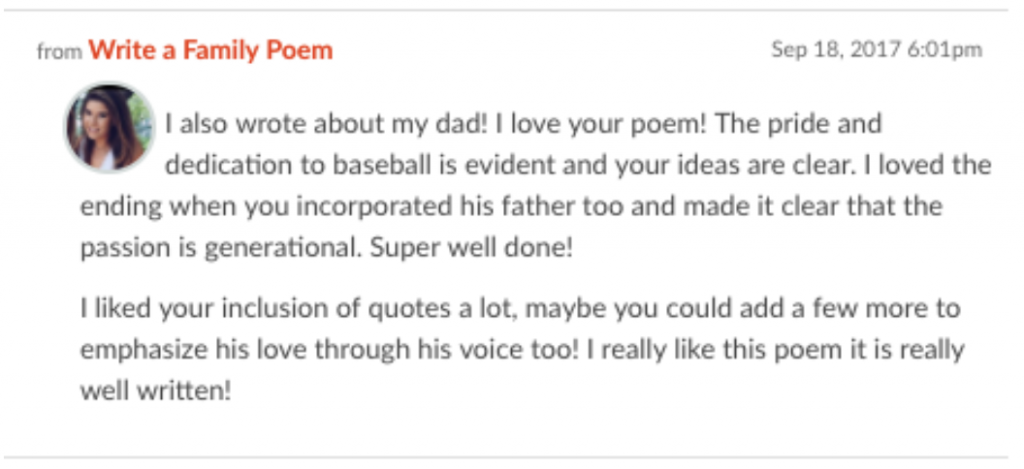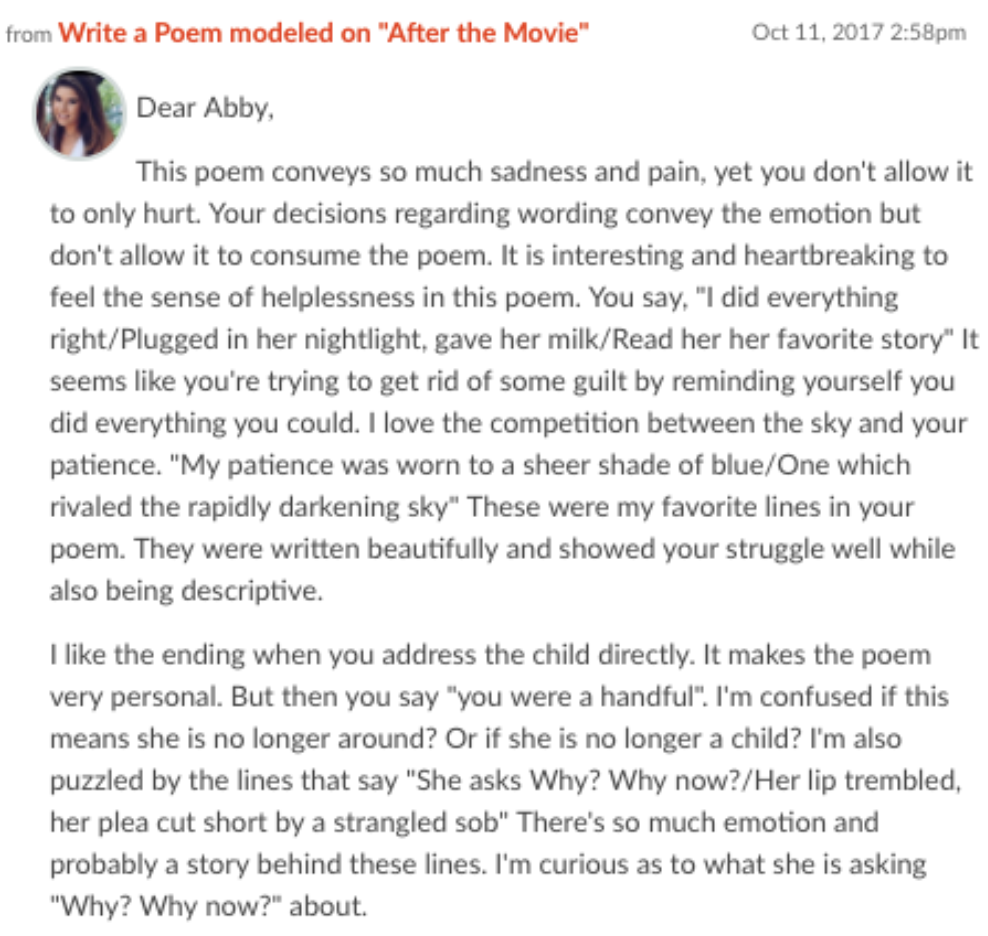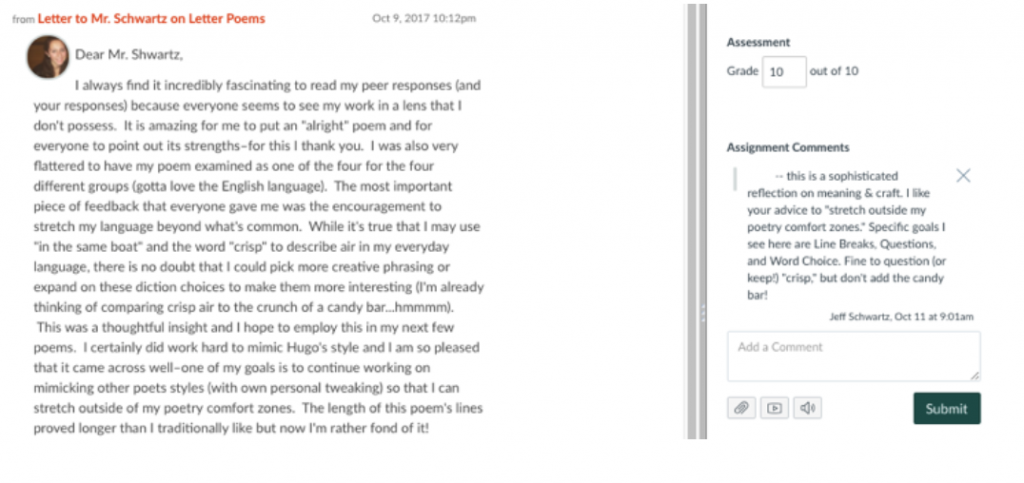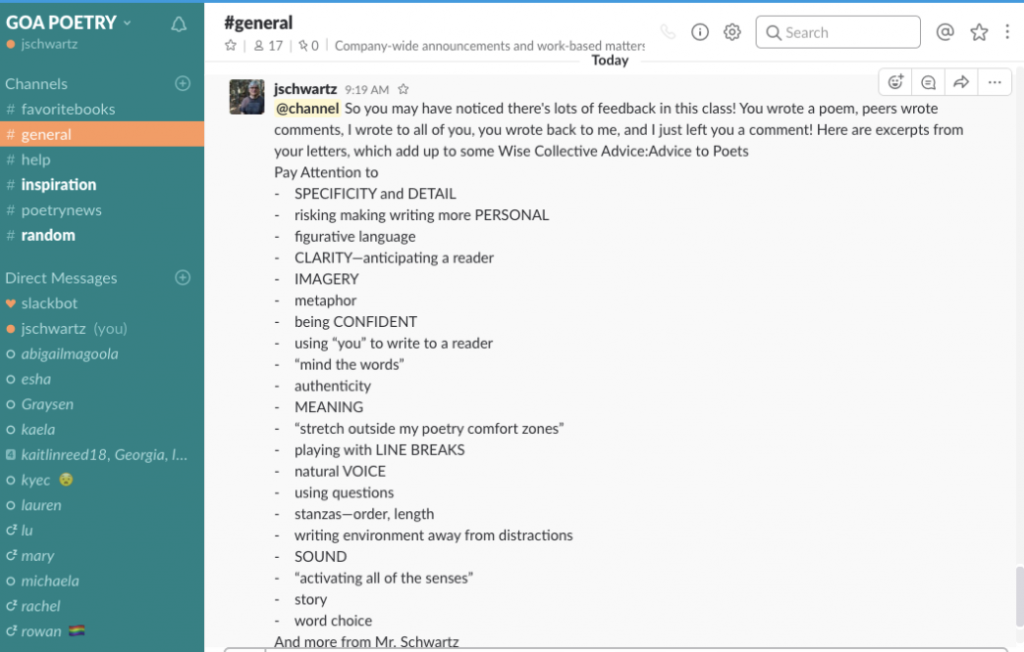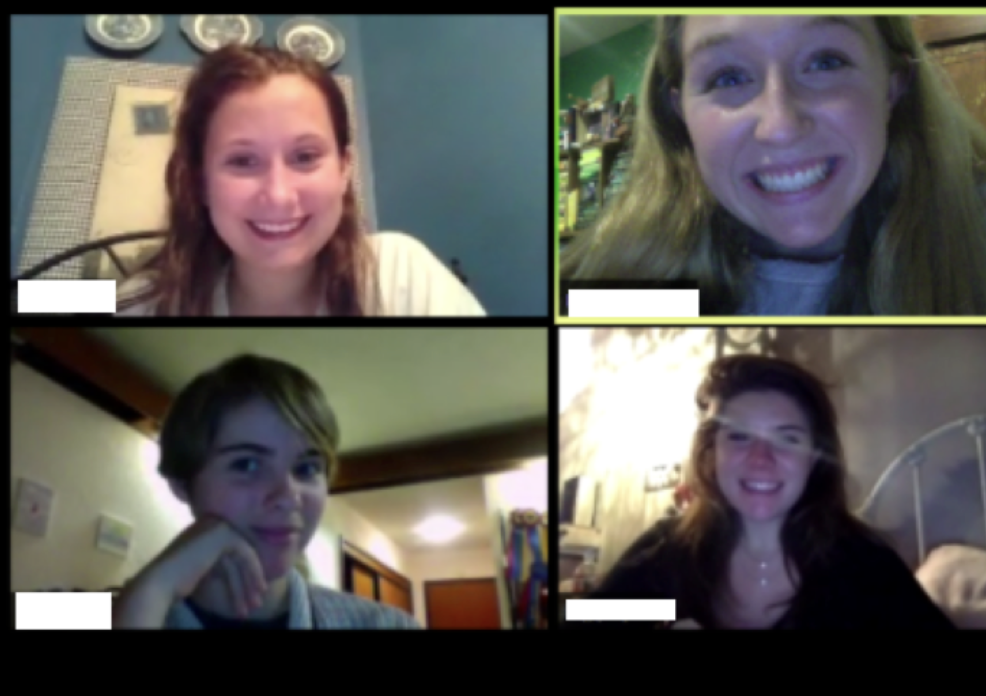All That Jazz: Using Feedback to Make Learning Visible
By Jeff Schwartz, GOA Faculty Member and educator, Greenwich Academy
After five years of teaching GOA Poetry Writing, an online course at Global Online Academy, I continue to learn how to create multi-layered feedback. My students give each other feedback, I give them feedback, and they give me feedback. When it works, we all learn. There’s a sort of triangle effect, and it doesn’t flow in one direction. As a matter of fact, it crosses paths so frequently and with such growing complexity that one challenge is keeping track of all the notes.
Maybe feedback is like jazz—sometimes solo, sometimes collaborative, and with players riffing back and forth off a known melody. There’s some improvisation and missteps in the process, but that’s all part of the art. The musicians—or in my case, the poets—listen and call to each other. They use feedback to push themselves and each other deeper into the creative process.
In the course, here are 5 ways I use feedback to make learning more visible.
1. Create a Trusting Community with Clear Goals
One Sunday evening early in the course, the class met on Zoom to get to know each other and to begin a list of criteria of what to look for when we write poems and offer feedback. Even with students in seven time zones, 13 (out of 17) of us were able to meet.
Here are 12 of our writing ensemble:
In the first half of GOA Poetry Writing, we work to form a community and to create a safe space to take risks. Students have to trust me, each other, and themselves. Feedback has to be learned and practiced, but everyone can master it. Giving feedback to a teenager’s poetry, as you can imagine, is a delicate task. It has to be kind, constructive, and well-supported. Among the goals are to build confidence, to increase awareness of craft in reading and writing poetry, and to offer tactful and constructive feedback toward revision.
2. Scaffold Student to Student Feedback
Every week, in small groups of four or five, students share poetry drafts in writing and audio. In Canvas discussion threads, peer readers are required to structure feedback to drafts into two paragraphs—1st for appreciation and 2nd for improvements. Some students are gifted at praise! (They often use exclamation points.) Most need reminders to point to the text; in other words, to substantiate claims with evidence.
Here’s an example from one student’s early round of peer feedback in September:
Here’s an example from the same student three weeks later. All of the students improved, but here you can see how this poet has expanded the specificity and depth of her feedback so that it is more helpful to the writer, the peer group, me, and even herself.
The appreciation paragraph is easy to learn. Harder is the paragraph on tactful suggestions, which, essentially, is where the learning happens both for reader and for writer. This reader substantiates her observations with exact quotes; she raises questions and uses “I” statements instead of prescribing; and she’s conscious of tone. Her growing awareness of her reader will also help her as writer. Reading and writing go hand in hand. As the young poets get better at assessing each other’s poems (as well as the weekly Featured Poets who have many book publications), they are building skills for giving themselves feedback.
3. Provide Opportunities to Layer Teacher to Student to Teacher Feedback
In addition to peer comments, I’m modeling how to write the two-paragraph comments, which I share each week in a public module on Canvas. I also leave individual, personalized comments and a low-stakes grade on all of the students’ peer feedback, urging them to use more specific examples, to notice more elements of craft, to ask more questions, and also to step back and see the poem as a whole. Keeping track of progress is messy work; in addition to Canvas, I find that I need to create charts with hand-written notes so that I can make learning visible and reinforce progress. Through all these layers of peer-, teacher- and self-feedback, the poets are learning what to look for in poems and applying it to next week’s draft.
At certain points in the course, I also ask students to reflect on the value of peer and teacher comments. You might say this round of correspondence is a meta-meta reflection, as students write to me reflecting on comments they received on their poetry drafts. This constant reinforcement of writing and reflecting helps develop critical tools that will help them become better writers and better readers of each other’s work. These spirals of feedback push them deeper into language and process. Since they’re not graded, though, it’s less self-conscious than it may seem. As a matter of fact, some of these layers are written as informal letters, emphasizing the personal nature of writing to a real audience.
Here’s one example of a letter, reflecting on feedback, which essentially is a self-assessment, including goals.
4. Use EdPuzzle and Slack to Reinforce Student Goals
How do I know the GOA students read my feedback? How do they set their own goals? This is where it helps to be even more multi-layered. Every week, I use EdPuzzle to check in. EdPuzzle allows me to create a short video, insert open-ended questions, monitor that students indeed watched the videos, and keep track of their goals. For example, I ask them to read through my comments and synthesize what is most helpful. I ask them to set goals based on their peers’, my, and their own feedback. What do you want to work on most for the next poem? On a more global level, I solicit feedback for improving the course. EdPuzzle allows me to reinforce goals and comments that are articulated in Canvas.
This year, I’ve also used Slack, which adds to the immediate, personal, and informal communication to individuals, pairs, and groups. Sometimes, I’ll upload a document to Slack that synthesizes students’ individual notes into one shared document. Here’s a screenshot of Slack after synthesizing their list (from Zoom and from written comments) on what elements of craft to look for in peer comments.
5. Foster Independent Learners Through Peer Groups on Zoom
Because I want students, most of all, to become independent learners, in the second half of the course, I push them to work more on their own without me. Now that they are expert with the written format, I’ll ask them to go “live,” that is to meet in small groups on Zoom to give each other oral feedback. There’s a clear structure for those groups and tasks, as well as written notes and a screenshot of the Zoom meeting to show accountability. Whether they work perfectly is not the point. 1) They are practicing methods of feedback they learned to give more safely in writing; 2) they are getting to know each other better; and 3) they are doing all this on their own without a teacher. What is better than that?
Here’s one of our recent quartets having fun, while sharing poems and jamming in a Zoom Room:
If feedback is like jazz, then it’s in the rehearsals—not the final concerts—where the learning happens. It’s where students are encouraged to take risks and learn from mistakes. Drafts are always in progress, always improvable. Learning, too, never sits still. Writers develop their chops in low-stakes drafting. And then through layers of cross-directional feedback, learning becomes visible. The spirals of call and response can be as wailing or as muted as a jazz trumpeter stretching her notes.
For more, see:
- From Theory to Practice: How Teachers are Implementing Competency-Based Learning
- Modern Learning: Making Learning Meaningful
- The 6 Questions We Should Be Asking about the Future of Learning
- Progress not Praise: How to Design Feedback for Competency-Based Learning
Global Online Academy (GOA) reimagines learning to empower students and teachers to thrive in a globally networked society. Professional learning opportunities are open to any educator. To sign up or to learn more, see our Professional Learning Opportunities for Educators or email hello@GlobalOnlineAcademy.org with the subject title “Professional Learning.” Follow us on Twitter @GOALearning. To stay up to date on GOA learning opportunities, sign up for our newsletter here.
